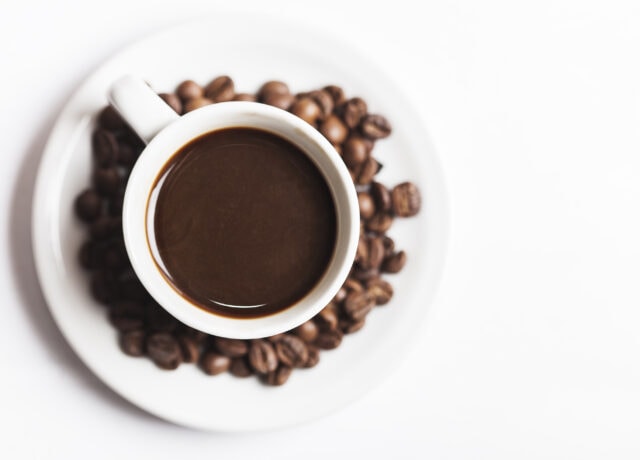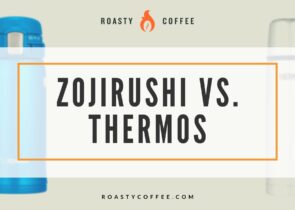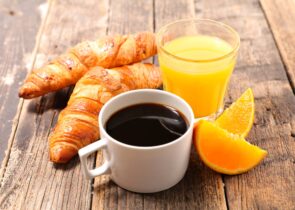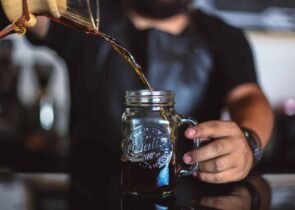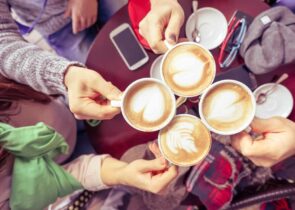So, you’ve picked up some equipment to make pour-overs at home. How hard can it be, after all? The barista at your local café certainly makes it look easy.
However, a quick search online about pour-over recipes might leave you with more questions than answers. Things like brew ratios and extraction yields can indeed dampen that initial excitement of being a home barista.
Don’t fret, though- you’ve come to the right place! I’ve provided consultation and training for all kinds of pour-over coffee programs — from a spartan setup in a Japanese sushi bar to the elaborate configuration of a third-wave coffee shop.
In this guide, I’ve put together the best bits of what matters most in a home setting. We’ve also included a handy coffee-to-water calculator that eliminates a lot of the guesswork in creating a pour-over recipe. Let’s get brewing!
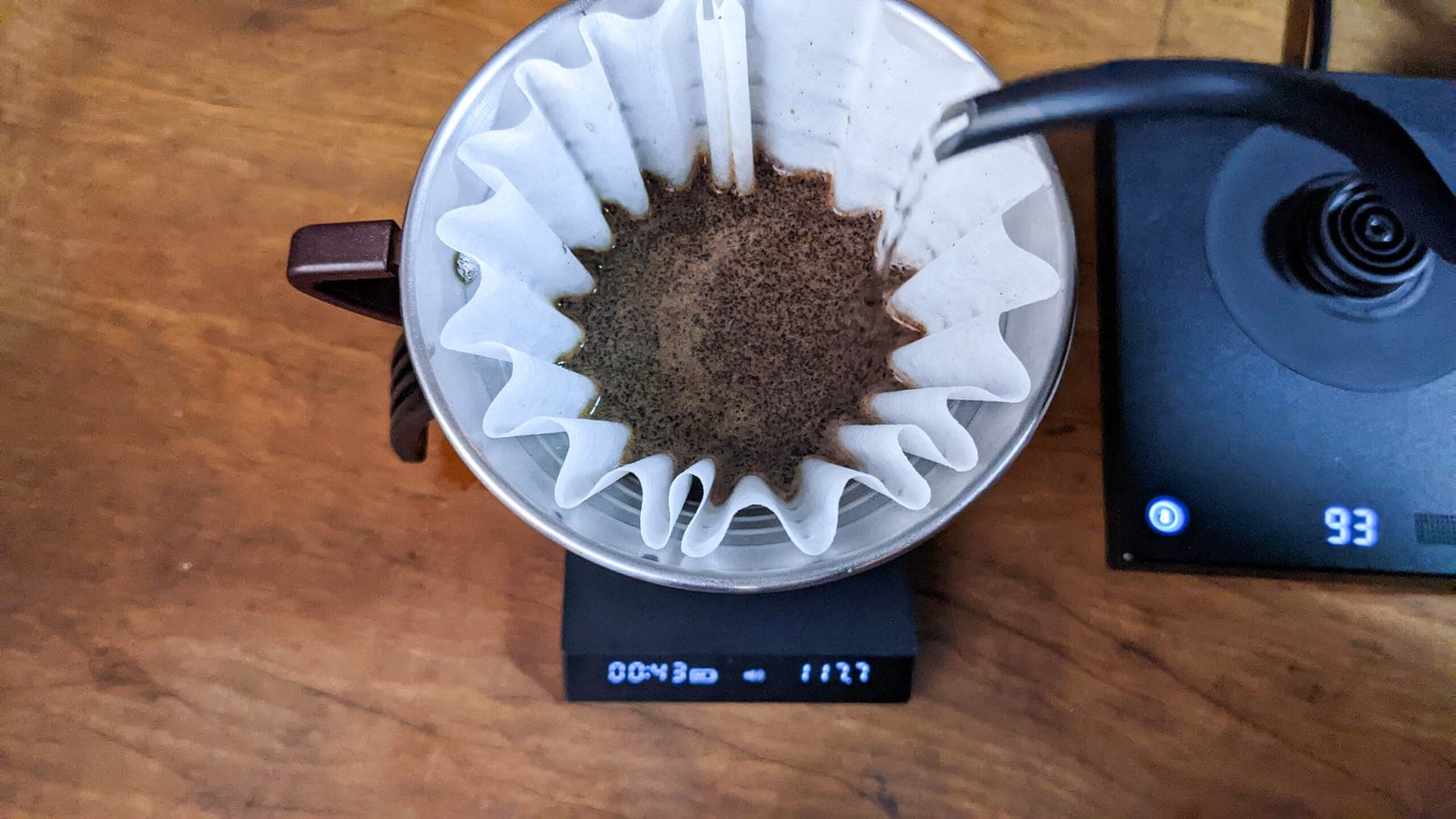
The Coffee-to-Water Ratio Calculator
We’ve kept it simple, so you can dive right in. Just set your preferences in the handy calculator below, and you’ll have a recipe ready to go!

Coffee to Water Calculator
Here’s a quick calculator we created to make the process really simple. All you have to do is pick the following: your brewer of choice, how much coffee you want, and how strong you want it.
We’ve created brew strength presets for every method that will provide a good starting point. If you want to skip our recommendations and play around with your own ratios, you can do that as well.
One last step — tell our calculator your favored way to measure coffee and water. The result? A brew recipe that’s tailor-fit to your preferences!


Set your preferred brew strength by choosing from the preset ratios below, or create a custom ratio.





CALCULATING



Demystifying Cup Size
Just how much liquid is in a cup? The accepted American definition pegs it at around 8 fl. oz. (fluid ounces). North of the border, you get less liquid at 7.6 fl. oz. per Canadian cup. In Japan? Cups are an even smaller 6.7 fl. oz.
Adding to the confusion are the cup sizes of both manual and automatic drip machines, ranging from 4 to 6 fl. oz.! Truly confusing stuff indeed.
For our calculator, we’ve gone with what the coffee experts use. The Specialty Coffee Association (SCA) standard of a cup of coffee is defined as 6 fluid ounces of water before brewing. This will produce 5.33 fl. oz. of brewed coffee.
Say you want to fill a 12-ounce cup; simply choose two cups from our calculator. Do take note that the actual liquid you get is closer to 11 fl. oz., but following this definition ties in splendidly with the Golden Cup Standard of brewing, which we’ll get to in the next section.
Brew Strength and Ratios
The easiest way to understand and tweak a coffee recipe is through its coffee-to-water ratio, also called the brew ratio. With this in mind, it becomes easy to visualize how adding (or reducing) the amount of coffee in the recipe intensifies (or weakens) the brew.
The concepts that follow will make better sense if a digital scale is part of your brewing workflow. However, I think that established brewing standards make for interesting reading, even if you’re sticking to good ol’ tablespoons!
The Golden Cup Standard
Both the National Coffee Association and the Specialty Coffee Association define this standard as two tablespoons of ground coffee for every six fluid ounces of brewing water.
This is based on the Coffee Brewing Control Chart, where a balanced cup of coffee has a ratio of 55 grams of coffee per liter of brewing water, or simply 55g/L. This is simplified even further as 1:18.
All those numbers might not make sense if you use volumetric measurements, but switching to weight-based measurement clarifies things. A tablespoon of coffee is about five grams, while one fluid ounce is about thirty.
In other words, the metric equivalent of Golden Cup Standard is 10 grams of coffee for every 180 grams (or milliliters, same thing!) of water.
It might be tempting to follow the Golden Cup Standard and call it a day. But in practice, things just aren’t that simple! Here’s how we determined our brew ratios for intensity based on existing standards and our own experience.
A Mild Pour Over
For this, we default to the Golden Cup Standard as defined above. Yes, ‘balanced’ hardly means ‘mild’. But in practice, a 1:18 brew ratio is likely to give you cups of coffee that might be perceived as mild or light.
How come, you might ask? In the most ideal situation involving high-end equipment and impeccable technique, the added water ensures a fuller extraction of the coffee’s flavors. For the average joe, it might simply result in a diluted brew.
So, when should you pick ‘Mild’? If punchy flavors aren’t your jam, then this will give you a very drinkable cup. Light roasts too, which are relatively less soluble, are likely to taste better due to the extraction benefits of this ratio.
A Strong Pour Over
Before it was cool to push the envelope of extraction, many cafés brewed their pour overs slightly under-extracted, but with intense flavors and a thicker mouthfeel.
A coffee-to-water ratio of 1:15 was a popular choice that made it easy for baristas and home brewers to make out a coffee’s flavor notes.
Pick ‘Strong’ for a rich and tasty cup of coffee that balances the body with sweetness and acidity. There’s enough oomph in there for a bit of dilution, too, if you like adding milk to your brew.
A Regular-Strength Pour Over
Whenever I brew a coffee for the first time, I default to a coffee-to-water ratio of 60g/L, or 1:16.67. And it’s not just me! Many cafés have adopted this classic brew ratio because it’s likely to work for a wide range of coffees.
It might not be the best one to use for every instance, but it will give you a drinkable starting point at the very least. If you think the coffee can taste better, then simply go stronger or milder, depending on your taste preferences.
Testing Tricky Tablespoons
We’ve previously mentioned that a tablespoon holds about 5 grams of coffee. Our calculator uses this conversion not only because it’s a popular Internet answer but also because we’ve actually hit 5 grams multiple times in our testing. But as you’ll see below, this doesn’t always happen.
The thing is, volumetric measurements are seriously inaccurate, which is why we recommend the use of digital scales for the best brewing results. (Check out our picks here!)
But if tablespoons and cups remain your measuring tools of choice, then check out our inside scoop on how you can make it work better for you!
My Testing Method
I’ve picked three coffees to test for this exercise. A dark-roasted Panama Boquete, a medium-roasted Costa Rica Tarrazu, and a light-roasted Philippines Liberica.
Heaping tablespoons were used in every test to simulate real-world scooping conditions. How come? Tablespoons are the most popular volumetric tool for coffee, and I think most people default to heaping scoops — I certainly don’t level mine!
The weight of each scoop was measured by emptying the coffee into a container on top of a calibrated digital scale with 0.1g accuracy. Each test was performed on each sample three times, with the average noted down as the result.
Test One: Scooping Whole Bean vs Ground Coffee
Is it more accurate to measure out whole beans or ground coffee with a tablespoon?
That’s what I wanted to figure out with this first test. I predicted that the variety in the shapes and sizes of coffee beans will give weight readings that don’t match up with their ground counterparts. This can be problematic if you only have access to pre-ground coffee.
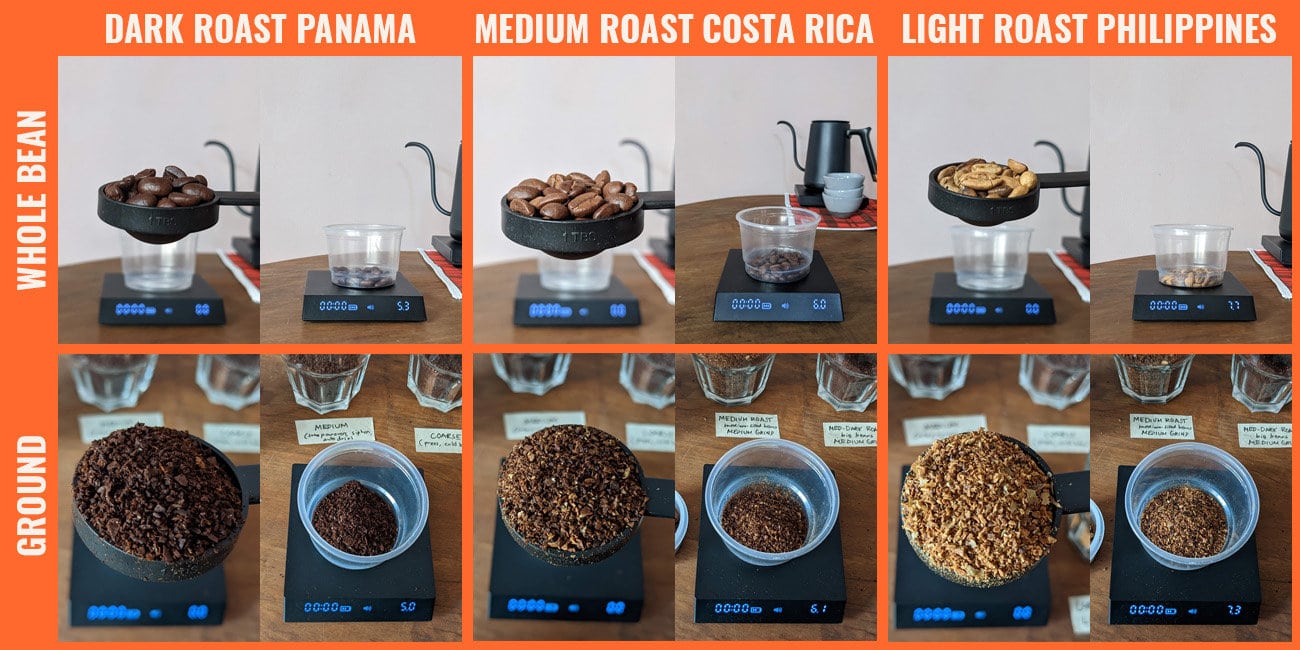
Boy was I wrong! A heaping tablespoon of coffee beans shows near-identical weight readings when compared with its ground-up counterpart!
Take the Dark Roast Panama coffee, for instance: The average weight of a bean-filled tablespoon was 5.3 grams. Ground for pour-over, the average weight was 5.0 grams.
With this discovery, we can be more flexible when following a pour-over recipe. You can use a tablespoon to measure out coffee beans so that you only grind what you need. If you’re limited to pre-ground coffee, then feel free to simply do the same!
Test Two: Dark vs Medium vs Light Roast
While the first test caught me off-guard, I was 101% sure about the results of this one.
Dark-roasted coffees weigh less than their medium and light-roasted counterparts. Longer exposure to heat during the roasting process evaporates more of the coffee’s moisture and ejects more of its silverskin. The darker you go, the lighter the beans get.
Let’s compare the heaping tablespoon weights of three coffees roasted differently, using the ground samples from the previous test:
| Coffee (ground for pour-over) | Weight |
|---|---|
| Dark Roast Panama | 5.0g |
| Medium Roast Costa Rica | 6.3g |
| Light Roast Philippines | 7.4g |
Here’s the problem- our calculator’s definition of 5 grams per tablespoon is only accurate for dark roasts. Using the same tablespoon for light and medium roasts will give you more coffee for the same amount of water, which will mess with our coffee-to-water ratio.
What to do? Unless using a dark roast, opt to use less than the calculator recommends. Use about 1/5 less coffee for medium roasts and a 1/3 less coffee for light roasts.
Examples:
For a medium-roast coffee: If the recipe calls for 5 tbsp, use 4 instead
For a light-roast coffee: If the recipe calls for 3 tbsp, use 2 instead
It’s a clunky solution, but it should help keep you close to your intended recipe.
Test Three: Grind Size Differences
Part of the appeal of the pour-over method is the wide variety of brewers available in the market. They differ not only in material and appearance but also in the pattern of their interior ridges and the number and size of drain holes at the bottom.
(Check this article out for a comparison of the Chemex versus other pour-over dripper styles!)
The ideal grind size for coffee grounds differs slightly among pour-over drippers because of these physical differences. A large-exit pour-over brewer like the Hario V60, for instance, favors a finer grind than a Beehouse with its two tiny drain holes.
We’ve exaggerated the grind size variations in our final test to see how it affects the weight of a heaping tablespoon.
Our sample for this test was our Dark Roast Panama coffee, ground three ways: Fine enough for a moka pot, medium for a pour-over, and coarse enough for a French press.
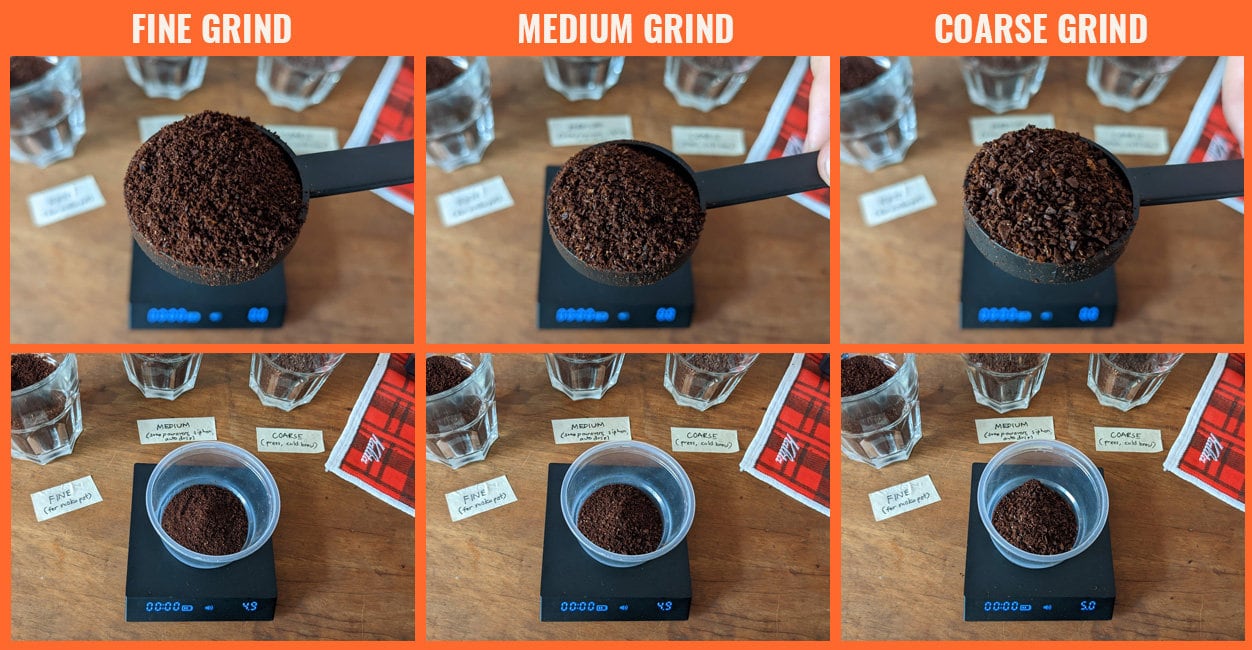
The results of our final test are quite clear: different grind sizes are not an issue when it comes to volumetric accuracy. So, you can rest easy that your trusty tablespoon won’t let you down, even if you swap brewing methods!
Putting It All Together
So far, we’ve given you a pour-over recipe based on your preferences and detailed explanations behind each of the variables. Now it’s time to brew one for yourself!
Here’s a simple brewing technique that ticks the required boxes of a good brew without being overly complicated.
(For a more detailed look at the brewing process, check out our guide!)
What You Need For a Pour Over
- Pour over dripper (we’re using the Kalita Wave 185 for this example)
- Electric or stovetop kettle (preferably one with a gooseneck spout)
- Coffee beans
- Coffee grinder (preferably a burr grinder)
- Digital scale (or tablespoons and measuring cups)
- Timer
- Serving carafe or cup

Sample Pour-Over Recipe
First, I picked the following choices on the calculator:
- I want to make 1 cup
- I want my coffee ‘Strong’
- I use grams to measure my coffee
The calculator gives us this coffee-to-water ratio, which we’ll use for our brew:
- 12g coffee
- 180g water
Prepare Your Brew Water
It’s good practice to heat water in your kettle before anything else, as you’ll have enough time to set up your station and grind your coffee before the water boils.
The ideal temperature for brewing coffee is between 195-205°F (90-96°C). If you don’t have any way to measure this, just use ‘off-the-boil’ water. Simply let your water boil, then shut the kettle off. Wait 30 seconds to 1 minute before brewing.
To make your life easier, consider investing in a variable-temperature electric kettle, such as the one in the photo. This smart device brings your water to a set temperature and holds it there until you’re ready to brew. The gooseneck spout is a bonus that will help you pour with precision!
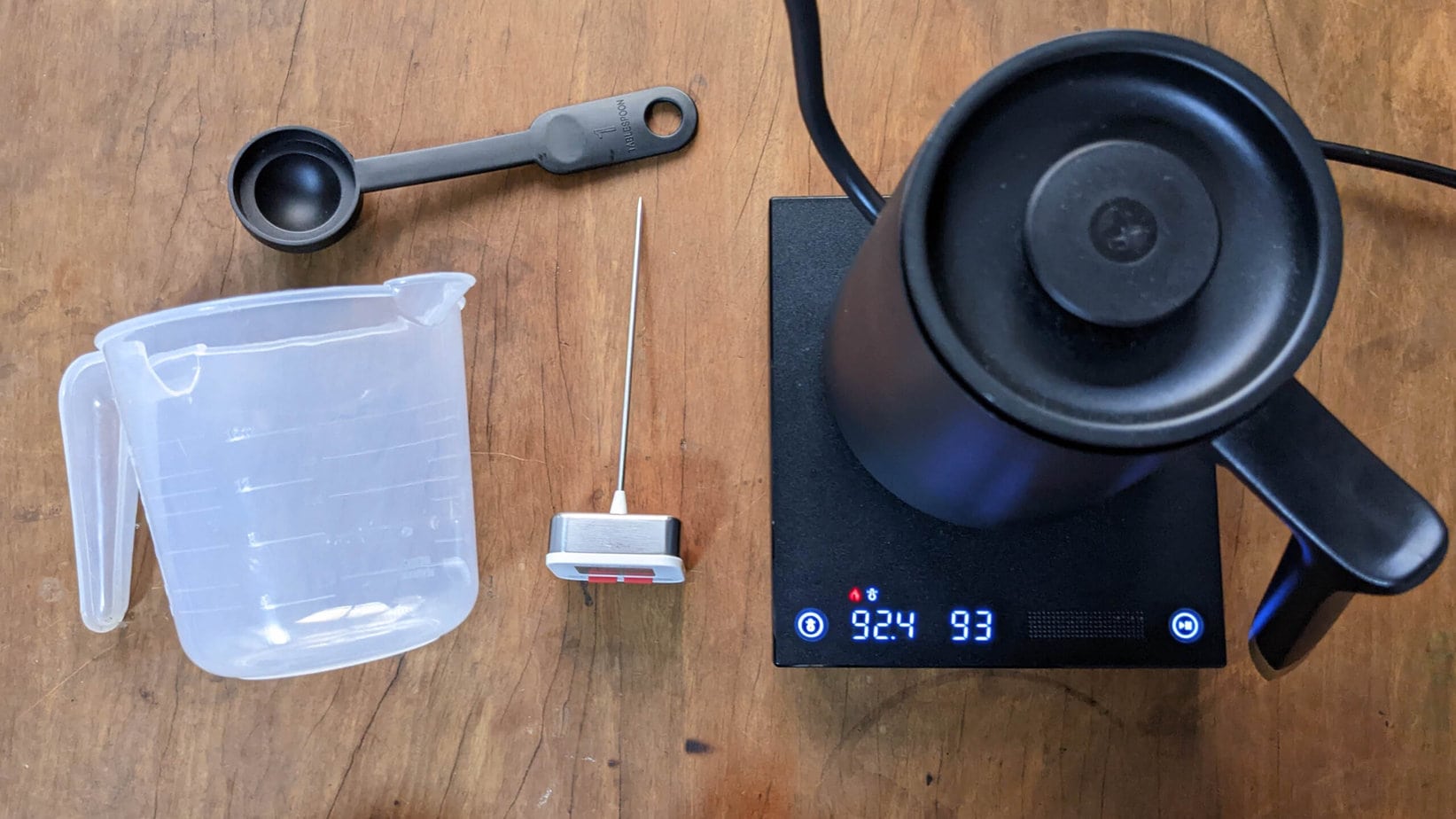
If you are using a digital scale, you can fill your kettle with more water than you need later on. In addition to the 180g required by the sample recipe, you will need extra hot water to rinse the coffee filter later.
If you are using cups to measure water, heat a bit of water in your kettle first. Use this to rinse the coffee filter. Empty out the kettle, and this time, fill it with the amount of water needed to brew your coffee. Our sample recipe of 180g (or ml) is roughly equal to about three-quarters of a cup.
Rinse and Pre-heat
Put your dripper on top of your serving carafe or cup, then place the coffee filter in the dripper. Pour hot water into the dripper in a circular motion, and be sure to soak all parts of the paper. The rinse water also heats up your dripper and serving vessel, which helps keep things toasty when you start brewing.

Remember to discard the water you used to rinse, or else your brew will taste both papery and diluted.
Prepare Your Coffee
Still following our sample recipe, measure out 12 grams of coffee, or 2.4 tablespoons. This will be ground to a medium consistency for the Kalita Wave dripper. For best results, grind your coffee just before you begin brewing.
Add the ground coffee to the center of the pre-wet filter. Keep the grounds as flat as possible by shaking or gently tapping the sides of the dripper.

Begin Brewing
Place your entire pour-over setup (including the serving vessel) on top of a scale if you are using one. With the scale tared (zeroed) and your stopwatch ready, begin the brewing process by pouring a tiny bit of water over the center of the grounds — just enough to fully saturate everything.
This process is called blooming. If your coffee is fresh, you’ll see the grounds swell and bubble up. Let it do its thing for 30 seconds.

Next, pour the rest of the water over the grounds in a slow and controlled manner. Start at the center, and move out in a spiral motion to evenly saturate all the grounds, then slowly circle back to the center.
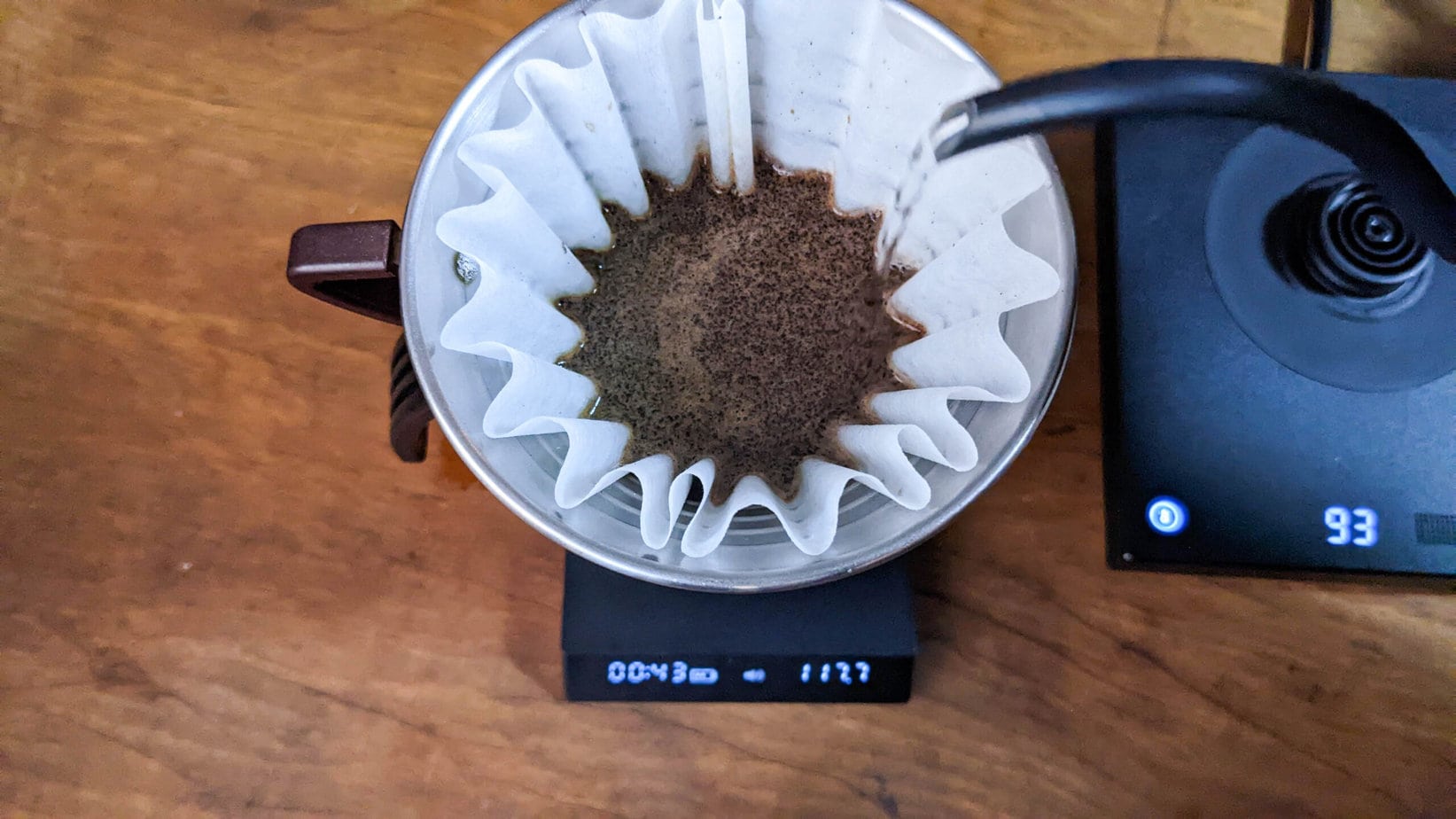
Stop when you’ve reached your target brew ratio (180g of water, in our case) — or for our volumetric friends, when your kettle has run out of water. You can do this in a single pour or in phases.
What’s more important is to keep the water level in the dripper even throughout the brewing process.
Allow the dripper to fully drain before removing it from your serving vessel. For a one or two-cup dripper, target a total brew time of 2 and a half to 3 minutes from start to finish. Now pour yourself some coffee and enjoy!

Final Thoughts
Learning pour-over concepts like coffee-to-water ratios might seem like a lot of work. However, by identifying and translating your preferences into a brew recipe, you give yourself the ability to make coffee that’s to your liking.
And if you find yourself enjoying the process, drop the tablespoons and spring for a scale!
Happy Caffeinating!


